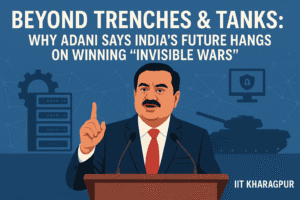Beyond Trenches & Tanks: Why Adani Says India’s Future Hangs on Winning “Invisible Wars”
Gautam Adani warned IIT Kharagpur students that India’s future hinges on winning “invisible wars” fought with algorithms and data, not conventional weapons. He highlighted critical vulnerabilities: 95% semiconductor imports, 85% fuel dependence, imported defense tech, and data sovereignty risks where exported data fuels foreign dominance. A single disruption or geopolitical event, he stressed, could cripple India’s digital economy or growth.
Adani framed overcoming these dependencies through technological self-reliance (‘aatmanirbharta’) as an existential battle for true freedom. He credited government institutions like ISRO and DRDO for laying India’s modern economic foundation but emphasized that industry bears equal responsibility for driving innovation. Academia’s role in developing talent and breakthroughs is crucial. Ultimately, securing India’s digital frontiers and mastering these server-based conflicts is a shared national mission for security and global standing.

Beyond Trenches & Tanks: Why Adani Says India’s Future Hangs on Winning “Invisible Wars”
Gautam Adani’s address to IIT Kharagpur students wasn’t merely an industrialist’s pep talk; it was a stark warning about the critical, unseen battlegrounds that will define India’s future. Moving beyond conventional military might, Adani framed national security and prosperity through the lens of technology-driven “invisible wars” – conflicts waged not with guns in trenches, but with algorithms on server farms.
The Unseen Battlefields:
Adani painted a compelling picture of this new warfare:
- Weapons: Algorithms, not artillery.
- Empires: Data centres, not geographical territories.
- Armies: Botnets, not battalions.
- Vulnerability: A single disruption or sanction could cripple India’s burgeoning digital economy.
The Achilles’ Heels: Critical Dependencies
The core of Adani’s warning lay in exposing India’s profound technological and strategic dependencies – vulnerabilities that render the nation susceptible in these invisible conflicts:
- The Semiconductor Chasm: A staggering 95% of India’s semiconductors are imported. These tiny chips are the literal brains powering everything from smartphones to advanced weaponry, making this dependency a national security risk.
- The Energy Lifeline: 85% of India’s fuel is imported. This leaves the nation’s growth trajectory perilously exposed to global geopolitical instability or supply chain shocks – “a single geopolitical incident can restrict our growth.”
- Defense Dilemma: Critical defense equipment remains heavily reliant on imports, subjecting national security to “the political will and the supply chain of other nations.”
- Data Sovereignty Crisis: “When our data crosses our borders, every bit… becomes raw material for foreign algorithms, creates foreign wealth, and strengthens foreign dominance.” Adani highlighted how exported data fuels foreign economic and strategic advantages.
The Imperative of “Aatmanirbharta” (Self-Reliance):
Adani positioned overcoming these dependencies not just as an economic goal, but as the fundamental “freedom” India must fight for in the 21st century. True sovereignty, he argued, hinges on technological self-reliance – the ability to design, manufacture, and control the foundational technologies powering the modern world and its invisible wars.
A Shared Responsibility: Government, Industry, Academia
Adani outlined a collaborative path forward:
- Government’s Foundational Role: He credited government institutions (ISRO, DRDO, BARC) and initiatives (UPI, freight corridors, renewable grids) for laying the bedrock of India’s modern economy and technological achievements.
- Industry’s Innovation Mandate: “India Inc. holds equal responsibility,” Adani stated, urging businesses to drive innovation and bridge the current “innovation deficit,” building upon the foundations laid by public institutions.
- Academia’s Engine: Speaking at IIT Kharagpur, he implicitly charged premier institutions like the IITs with producing the talent and breakthroughs needed to secure India’s technological future.
The Stakes: India’s Destiny on the Digital Frontline
Adani’s message transcended corporate interest. It was a call to recognize that India’s future security, economic resilience, and global standing will be decisively shaped by its preparedness for non-kinetic, technology-centric conflicts. Winning these invisible wars requires:
- Breaking Critical Dependencies: Urgently addressing vulnerabilities in semiconductors, energy, defense, and data.
- Building Sovereign Capabilities: Fostering domestic innovation, manufacturing, and control over core technologies.
- Fostering Synergy: Creating a seamless ecosystem where government policy, industrial investment, and academic excellence converge to build national technological strength.
The challenge is immense, but the imperative is clear. As Adani framed it, India’s journey to becoming a truly free and globally influential power depends not just on its physical borders, but on its ability to secure its digital frontiers and master the invisible wars of the technological age. The call to action resonates far beyond the halls of IIT Kharagpur – it’s a national mission critical for survival and success in the decades ahead.
You must be logged in to post a comment.